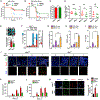Influenza Virus Z-RNAs Induce ZBP1-Mediated Necroptosis
- PMID: 32200799
- PMCID: PMC7153753
- DOI: 10.1016/j.cell.2020.02.050
Influenza Virus Z-RNAs Induce ZBP1-Mediated Necroptosis
Abstract
Influenza A virus (IAV) is a lytic RNA virus that triggers receptor-interacting serine/threonine-protein kinase 3 (RIPK3)-mediated pathways of apoptosis and mixed lineage kinase domain-like pseudokinase (MLKL)-dependent necroptosis in infected cells. ZBP1 initiates RIPK3-driven cell death by sensing IAV RNA and activating RIPK3. Here, we show that replicating IAV generates Z-RNAs, which activate ZBP1 in the nucleus of infected cells. ZBP1 then initiates RIPK3-mediated MLKL activation in the nucleus, resulting in nuclear envelope disruption, leakage of DNA into the cytosol, and eventual necroptosis. Cell death induced by nuclear MLKL was a potent activator of neutrophils, a cell type known to drive inflammatory pathology in virulent IAV disease. Consequently, MLKL-deficient mice manifest reduced nuclear disruption of lung epithelia, decreased neutrophil recruitment into infected lungs, and increased survival following a lethal dose of IAV. These results implicate Z-RNA as a new pathogen-associated molecular pattern and describe a ZBP1-initiated nucleus-to-plasma membrane "inside-out" death pathway with potentially pathogenic consequences in severe cases of influenza.
Keywords: MLKL; RIPK3; Z-RNA; ZBP1; apoptosis; caspase-8; dsRNA; influenza; necroptosis.
Copyright © 2020 Elsevier Inc. All rights reserved.
Conflict of interest statement
Declaration of Interests The authors declare no competing interests.
Figures







References
-
- Athanasiadis A (2012). Zalpha-domains: at the intersection between RNA editing and innate immunity. Semin. Cell Dev. Biol 23, 275–280. - PubMed
Publication types
MeSH terms
Substances
Grants and funding
- R21 AI135709/AI/NIAID NIH HHS/United States
- R01 CA168621/CA/NCI NIH HHS/United States
- HHSN272201400006C/AI/NIAID NIH HHS/United States
- R01 AI144400/AI/NIAID NIH HHS/United States
- R01 AI121832/AI/NIAID NIH HHS/United States
- R01 CA190542/CA/NCI NIH HHS/United States
- R01 AI135025/AI/NIAID NIH HHS/United States
- R01 AI137062/AI/NIAID NIH HHS/United States
- R35 CA231620/CA/NCI NIH HHS/United States
- R01 AI044828/AI/NIAID NIH HHS/United States
- R01 AI134862/AI/NIAID NIH HHS/United States
- R37 AI044828/AI/NIAID NIH HHS/United States
- P30 CA006927/CA/NCI NIH HHS/United States
LinkOut - more resources
Full Text Sources
Other Literature Sources
Molecular Biology Databases
Miscellaneous

